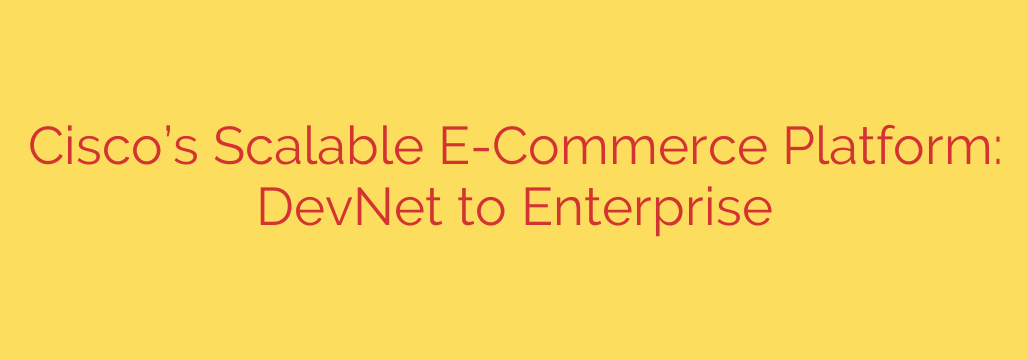
From Developer Sandbox to Global Enterprise: The Blueprint for a Scalable E-Commerce Platform
In today’s fast-paced digital economy, the ability to sell and manage products online isn’t just a feature—it’s the backbone of a modern enterprise. However, many large organizations find themselves trapped by complex, outdated e-commerce systems that hinder growth and frustrate customers. The journey from a fragmented, legacy infrastructure to a streamlined, scalable digital commerce engine is one of the most critical transformations a company can undertake.
This transformation requires more than just new technology; it demands a strategic shift in thinking. By examining the core principles of building a platform designed for growth, we can uncover a blueprint for success that applies to any organization looking to modernize its digital sales channels. The key is to start with a focused audience, prove the model, and scale intelligently.
The Challenge: Untangling the Web of Legacy Systems
For any established enterprise, the starting point is often a collection of siloed systems. Different business units might use separate purchasing portals, license management tools, and support desks. This creates a disjointed and confusing experience for customers, who simply want a single, easy-to-use interface to do business.
These legacy platforms are often:
- Difficult to update, leading to slow deployment of new products and pricing models.
- Expensive to maintain, consuming valuable IT resources that could be used for innovation.
- Not built for modern subscription or API-based services, creating a major roadblock for digital transformation.
The goal is to replace this complexity with a unified, self-service platform that offers a consistent and intuitive experience for every user, from an individual developer to a multinational corporation.
The Strategy: Start Small, Iterate, and Scale with Confidence
A “big bang” approach to replacing an entire enterprise e-commerce system is incredibly risky. A far more effective strategy is to begin with a controlled, specific use case. The ideal starting point is a tech-savvy audience that can provide valuable feedback and tolerate the occasional hiccup of a new system.
For example, starting with a developer community allows you to test and refine the platform in a real-world environment. This initial phase serves as a crucial proof-of-concept. The core principle is to build a Minimum Viable Product (MVP) that solves a real problem for a niche audience first.
By focusing on a single group, you can:
- Gather direct user feedback to quickly identify and fix issues.
- Validate the core architecture and ensure it can handle transactions, identity management, and subscriptions reliably.
- Build momentum and internal buy-in by demonstrating early success before requesting a massive, enterprise-wide investment.
Once the platform is proven and stable, it can be methodically expanded to serve larger and more diverse customer segments, eventually becoming the single commerce engine for the entire organization.
The Architectural Foundation for Growth
To support this scalable model, the underlying technology must be modern, flexible, and resilient. Three architectural pillars are essential for building a future-proof enterprise e-commerce platform.
A Microservices-Based Architecture: Instead of a single, monolithic application, a modern platform is built from dozens of smaller, independent services. There might be separate services for user identity, the product catalog, the shopping cart, payments, and license fulfillment. This microservices approach allows development teams to update individual components without affecting the entire system, leading to faster innovation and greater stability.
An API-First Design: The platform’s entire functionality should be accessible through Application Programming Interfaces (APIs). An API-first strategy ensures that the commerce engine is “headless,” meaning the backend logic is completely separate from the frontend user interface. This provides enormous flexibility, allowing the same commerce engine to power a public website, a partner portal, a mobile app, or even integrate directly into a customer’s own procurement systems.
A Unified Customer Identity: One of the biggest frustrations for customers is needing different logins for different services from the same company. Establishing a single, secure identity system is non-negotiable. This ensures that a customer has one account to access everything—from purchasing a new software subscription to accessing developer resources and opening a support ticket.
Actionable Takeaways for Your Digital Transformation
Building a scalable e-commerce platform is a journey, not a destination. Whether you are a growing startup or a global enterprise, the fundamental principles remain the same.
- Prioritize the Customer Experience: Design every step of the process from the customer’s point of view. A simple, self-service portal that empowers users is the ultimate goal.
- Embrace Automation: Automate everything from provisioning new services to managing subscription renewals. This reduces operational costs and eliminates human error, allowing your teams to focus on high-value work.
- Build on a Flexible Foundation: Choose an architecture (like microservices and APIs) that allows for change and growth. The business will evolve, and your platform must be able to evolve with it.
- Make Security a Day-One Priority: In an enterprise environment, security and compliance are paramount. Integrate robust security measures into every layer of the platform from the very beginning, rather than treating it as an afterthought.
By adopting a smart, phased approach and building on a modern architectural foundation, any organization can move beyond its legacy limitations and create a powerful, scalable e-commerce engine that drives growth and delights customers.
Source: https://feedpress.me/link/23532/17123296/building-a-scalable-e-commerce-platform-at-cisco-from-devnet-to-company-wide-impact







